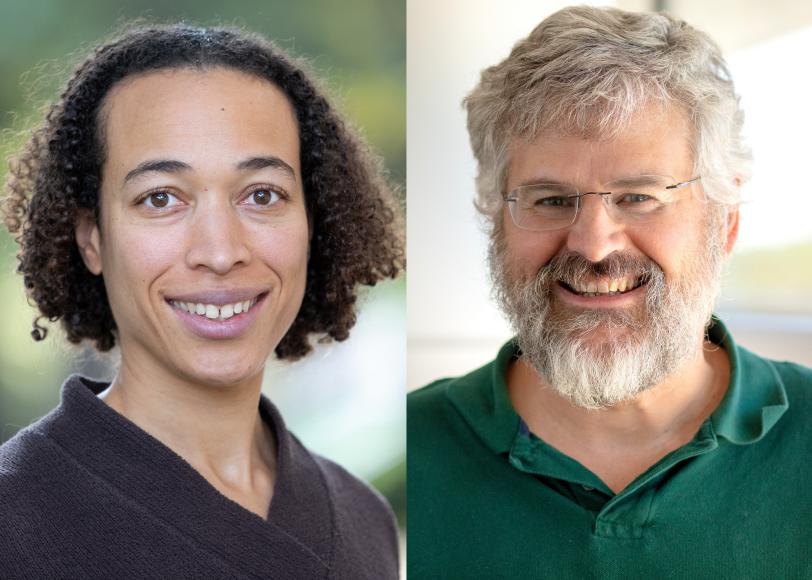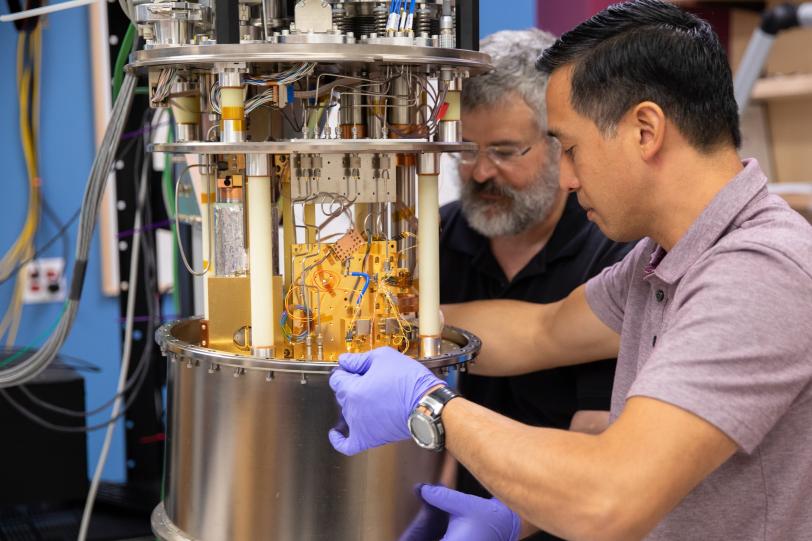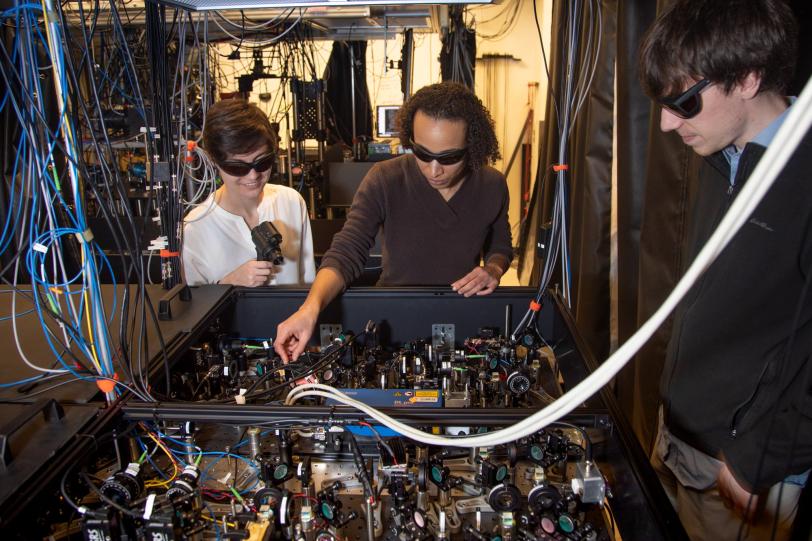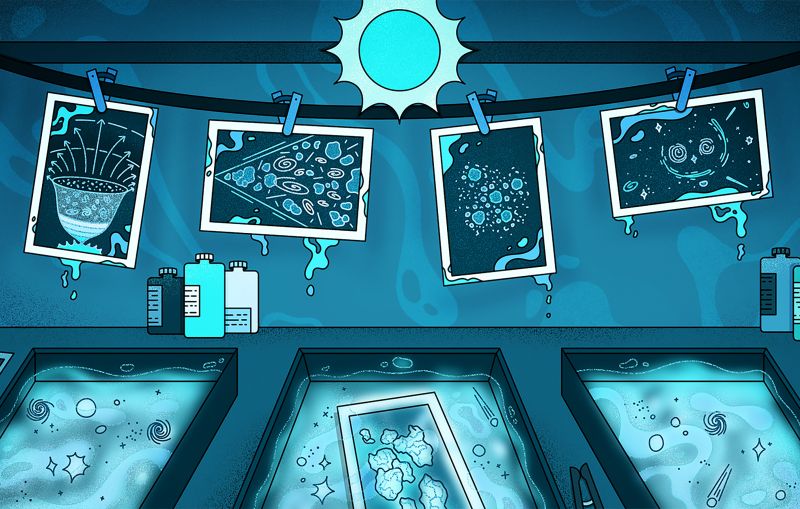Q&A: SLAC/Stanford researchers prepare for a new quantum revolution
Monika Schleier-Smith and Kent Irwin explain how their projects in quantum information science could help us better understand black holes and dark matter.
By Manuel Gnida
The tech world is abuzz about quantum information science (QIS). This emerging technology explores bizarre quantum effects that occur on the smallest scales of matter and could potentially revolutionize the way we live.
Quantum computers would outperform today’s most powerful supercomputers; data transfer technology based on quantum encryption would be more secure; exquisitely sensitive detectors could pick up fainter-than-ever signals from all corners of the universe; and new quantum materials could enable superconductors that transport electricity without loss.
In December 2018, President Trump signed the National Quantum Initiative Act into law, which will mobilize $1.2 billion over the next five years to accelerate the development of quantum technology and its applications. Three months earlier, the Department of Energy had already announced $218 million in funding for 85 QIS research awards.
The Fundamental Physics and Technology Innovation directorates of DOE’s SLAC National Accelerator Laboratory recently joined forces with Stanford University on a new initiative called Q-FARM to make progress in the field. In this Q&A, two Q-FARM scientists explain how they will explore the quantum world through projects funded by DOE QIS awards in high-energy physics.
Monika Schleier-Smith, assistant professor of physics at Stanford, wants to build a quantum simulator made of atoms to test how quantum information spreads. The research, she said, could even lead to a better understanding of black holes.
Kent Irwin, professor of physics at Stanford and professor of photon science and of particle physics and astrophysics at SLAC, works on quantum sensors that would open new avenues to search for the identity of the mysterious dark matter that makes up most of the universe.

What exactly is quantum information science?
Irwin: If we look at the world on the smallest scales, everything we know is already “quantum.” On this scale, the properties of atoms, molecules and materials follow the rules of quantum mechanics. QIS strives to make significant advances in controlling those quantum effects that don’t exist on larger scales.
Schleier-Smith: We’re truly witnessing a revolution in the field in the sense that we’re getting better and better at engineering systems with carefully designed quantum properties, which could pave the way for a broad range of future applications.
What does quantum control mean in practice?
Schleier-Smith: The most exciting opportunities in quantum control make use of a phenomenon known as entanglement – a type of correlation that doesn’t exist in the “classical,” non-quantum world. Let me give you a simple analogy: Imagine that we flip two coins. Classically, whether one coin shows heads or tails is independent of what the other coin shows. But if the two coins are instead in an entangled quantum state, looking at the result for one “coin” automatically determines the result for the other one, even though the coin toss still looks random for either coin in isolation.
Entanglement thus provides a fundamentally new way of encoding information – not in the states of individual “coins” or bits but in correlations between the states of different qubits. This capability could potentially enable transformative new ways of computing, where problems that are intrinsically difficult to solve on classical computers might be more efficiently solved on quantum ones. A challenge, however, is that entangled states are exceedingly fragile: any measurement of the system – even unintentional – necessarily changes the quantum state. So a major area of quantum control is to understand how to generate and preserve this fragile resource.
At the same time, certain quantum technologies can also take advantage of the extreme sensitivity of quantum states to perturbations. One application is in secure telecommunications: If a sender and receiver share information in the form of quantum bits, an eavesdropper cannot go undetected, because her measurement necessarily changes the quantum state.
Another very promising application is quantum sensing, where the idea is to reduce noise and enhance sensitivity by controlling quantum correlations, for instance, through quantum squeezing.
What is quantum squeezing?
Irwin: Quantum mechanics sets limits on how we can measure certain things in nature. For instance, we can’t perfectly measure both the position and momentum of a particle. The very act of measuring one changes the other. This is called the Heisenberg uncertainty principle. When we search for dark matter, we need to measure an electromagnetic signal extremely well, but Heisenberg tells us that we can’t measure the strength and timing of this signal without introducing uncertainty.
Quantum squeezing allows us to evade limits on measurement set by Heisenberg by putting all the uncertainty into one thing (which we don’t care about), and then measuring the other with much greater precision. So, for instance, if we squeeze all of the quantum uncertainty in an electromagnetic signal into its timing, we can measure its strength much better than quantum mechanics would ordinarily allow. This lets us search for an electromagnetic signal from dark matter much more quickly and sensitively than is otherwise possible.

What types of sensors are you working on?
Irwin: My team is exploring quantum techniques to develop sensors that could break new ground in the search for dark matter.
We’ve known since the 1930s that the universe contains much more matter than the ordinary type that we can see with our eyes and telescopes – the matter made up of atoms. Whatever dark matter is, it’s a new type of particle that we don’t understand yet. Most of today’s dark matter detectors search for relatively heavy particles, called weakly interacting massive particles, or WIMPs. But what if dark matter particles were so light that they wouldn’t leave a trace in those detectors? We want to develop sensors that would be able to “see” much lighter dark matter particles.
There would be so many of these very light dark matter particles that they would behave much more like waves than individual particles. So instead of looking for collisions of individual dark matter particles within a detector, which is how WIMP detectors work, we want to look for dark matter waves, which would be detected like a very weak AM radio signal.
In fact, we even call one of our projects “Dark Matter Radio.” It works like the world’s most sensitive AM radio. But it’s also placed in the world’s most perfect radio shield, made up of a material called a superconductor, which keeps all normal radio waves out. However, unlike real AM radio signals, dark matter waves would be able to go right through the shield and produce a signal. So we are looking for a very weak AM radio station made by dark matter at an unknown frequency.
Quantum sensors can make this radio much more sensitive, for instance by using quantum tricks such as squeezing and entanglement. So the Dark Matter Radio will not only be the world’s most sensitive AM radio; it will also be better than the Heisenberg uncertainty principle would normally allow.
What are the challenges of QIS?
Schleier-Smith: There is a lot we need to learn about controlling quantum correlations before we can make broad use of them in future applications. For example, the sensitivity of entangled quantum states to perturbations is great for sensor applications. However, for quantum computing it’s a major challenge because perturbations of information encoded in qubits will introduce errors, and nobody knows for sure how to correct for them.
To make progress in that area, my team is studying a question that is very fundamental to our ability to control quantum correlations: How does information actually spread in quantum systems?
The model system we’re using for these studies consists of atoms that are laser-cooled and optically trapped. We use light to controllably turn on interactions between the atoms, as a means of generating entanglement. By measuring the speed with which quantum information can spread in the system, we hope to understand how to design the structure of the interactions to generate entanglement most efficiently. We view the system of cold atoms as a quantum simulator that allows us to study principles that are also applicable to other physical systems.
In this area of quantum simulation, one major thrust has been to advance understanding of solid-state systems, by trapping atoms in arrays that mimic the structure of a crystalline material. In my lab, we are additionally working to extend the ideas and tools of quantum simulation in new directions. One prospect that I am particularly excited about is to use cold atoms to simulate what happens to quantum information in black holes.

What do cold atoms have to do with black holes?
Schleier-Smith: The idea that there might be any connection between quantum systems we can build in the lab and black holes has its origins in a long-standing theoretical problem: When particles fall into a black hole, what happens to the information they contained? There were compelling arguments that the information should be lost, but that would contradict the laws of quantum mechanics.
More recently, theoretical physicists – notably my Stanford colleague Patrick Hayden – found a resolution to this problem: We should think of the black hole as a highly chaotic system that “scrambles” the information as fast as physically possible. It’s almost like shredding documents, but quantum information scrambling is much richer in that the result is a highly entangled quantum state.
Although precisely recreating such a process in the lab will be very challenging, we hope to look at one of its key features already in the near term. In order for information scrambling to happen, information needs to be transferred through space exponentially fast. This, in turn, requires quantum interactions to occur over long distances, which is quite counterintuitive because interactions in nature typically become weaker with distance. With our quantum simulator, we are able to study interactions between distant atoms by sending information back and forth with photons, particles of light.
What do you hope will happen in QIS over the next few years?
Irwin: We need to prove that, in real applications, quantum technology is superior to the technology that we already have. We are in the early stages of this new quantum revolution, but this is already starting to happen. The things we’re learning now will help us make a leap in developing future technology, such as universal quantum computers and next-generation sensors. The work we do on quantum sensors will enable new science, not only in dark matter research. At SLAC, I also see potential for quantum-enhanced sensors in X-ray applications, which could provide us with new tools to study advanced materials and understand how biomolecules work.
Schleier-Smith: QIS offers plenty of room for breakthroughs. There are many open questions we still need to answer about how to engineer the properties of quantum systems in order to harness them for technology, so it’s imperative that we continue to broadly advance our understanding of complex quantum systems. Personally, I hope that we’ll be able to better connect experimental observations with the latest theoretical advances. Bringing all this knowledge together will help us build the technologies of the future.
For questions or comments, contact the SLAC Office of Communications at communications@slac.stanford.edu.
SLAC is a multi-program laboratory exploring frontier questions in photon science, astrophysics, particle physics and accelerator research. Located in Menlo Park, Calif., SLAC is operated by Stanford University for the U.S. Department of Energy's Office of Science.
SLAC National Accelerator Laboratory is supported by the Office of Science of the U.S. Department of Energy. The Office of Science is the single largest supporter of basic research in the physical sciences in the United States, and is working to address some of the most pressing challenges of our time. For more information, please visit science.energy.gov.





